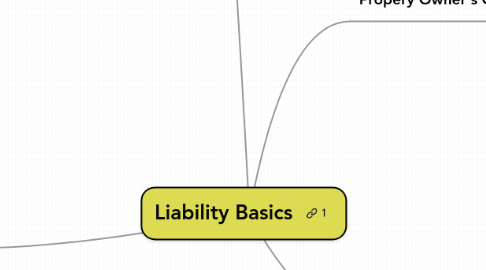
1. Damages
1.1. Occurrence.
1.1.1. An event that results in an insured loss
1.1.2. .
1.2. Bodily Injury Liability
1.2.1. liability arising from physical injury, including sickness, disease, and death caused by the negligent or purposeful acts or omissions of an insured.
1.2.2. .
1.3. .
1.3.1. Accident
1.3.1.1. unplanned event which occurs suddenly and at a definite place.
1.3.1.2. .
1.4. Property Damage Liability
1.4.1. Damage to tangible property, including loss of use of that property caused by the insured’s negligence
1.5. .
1.6. Personal Injury Liability
1.6.1. Libel (in print),
1.6.2. .
1.6.3. slander (spoken),
1.6.4. .
1.6.5. false arrest,
1.6.6. .
1.6.7. defamation
1.6.8. .
1.7. Advertising Injury Liability
1.7.1. Legal liability arising from the misappropriation of advertising ideas or style of doing business; infringement of copyright, title or slogan
1.8. .
1.9. Attractive Nuisance
1.9.1. Some properties attract and are a threat to children
1.10. .
1.11. Specific Damages
1.11.1. Compensation to an injured party for actual or known expenses such as bills, loss of earnings, or costs of repairing or replacing damaged property. Specific damages do not include pain and suffering
1.12. .
1.13. General Damages
1.13.1. Compensation to an injured party for pain, suffering, mental anguish, disfigurement
1.14. .
1.15. Punitive Damages
1.15.1. general damages as a punishment for extreme conduct by a negligent party, as in the case of gross negligence
1.16. .
1.17. Medical Payments Coverage
1.17.1. expenses incurred by invitees and licensees on the insured’s premises. Payments are made regardless of fault or negligence, and payment is not an admission of fault.
1.18. .
1.19. Gross Negligence
1.19.1. A willful, or reckless disregard of the consequences affecting the life or property of another.
1.20. .
1.21. Vicarious Liability
1.21.1. liability on one person for the actionable conduct of another (Such as: employer and employee)
1.21.2. .
1.21.3. Absolute Liability
1.21.3.1. Employers are absolutely liable for employees work related injuries regardless of fault
1.22. Strict Liability
1.22.1. .
1.22.2. If a claimant can prove that a product caused the injury, the manufacturer will be held liable whether or not the product was defective.
1.23. .
1.24. Notices of loss
1.25. .
1.26. Arbitration
1.26.1. Third party settles disagreements between claimant and the insurer
1.27. .
1.28. Certification of Insurance
1.28.1. Includes the effective date, name of the insurer, name of the insured, and limits of liability.
1.29. .
1.30. Libel
1.30.1. printed matter tending to unjustly injure a person’s reputation
1.31. .
1.32. Slander
1.32.1. oral falsehood that damages another’s reputation
2. Tort Law
2.1. Unintentional Torts / Civil wrong
2.1.1. negligence
2.1.1.1. Duty to act
2.1.1.1.1. act in a reasonably prudent manner toward another
2.1.1.2. .
2.1.1.3. Breach of the duty to act.
2.1.1.3.1. does not act in a reasonably prudent manner toward another
2.1.1.4. .
2.1.1.5. Occurrence of injury or damage.
2.1.1.5.1. Another party actually must suffer an injury or damage. Standard of Care.
2.1.1.6. .
2.1.1.7. proximate cause
2.1.1.7.1. tortfeasor’s breach of duty is actually what caused the injury or damage
2.2. Intentional wrong
2.2.1. Criminal
2.3. .
2.4. Defenses
2.4.1. Common Law (judicial or court decisions)
2.4.1.1. Contributory Negligence
2.4.1.1.1. Prevents recovery for damages caused by a negligent party if the claimant was also negligent
2.4.1.2. .
2.4.1.3. Assumption of Risk
2.4.1.3.1. plaintiff who consciously exposes himself to danger assumes some risk of possible injury.
2.4.1.4. .
2.4.1.5. Intervening Cause
2.4.1.5.1. disrupted chain of events, thus freeing the defendant from liability.
2.4.2. .
2.4.3. Statutory Law (enactment of legislatures)
2.4.3.1. Comparative Negligence
2.4.3.1.1. Damages are reduced in proportion to the degree of negligence.
2.4.3.2. .
2.4.3.3. Statute of Limitations
2.4.3.3.1. length of time in which a person may file suit.
2.4.3.3.2. .
2.4.3.3.3. .
2.4.4. .
2.4.5. No-Fault Concept
2.4.5.1. pure no-fault
2.4.5.1.1. tort system is completely abolished for bodily injuries caused by auto accidents.
2.4.5.2. .
2.4.5.3. modified no-fault
2.4.5.3.1. no-fault concept, limited immunity is provided from tort action
2.4.5.4. .
2.4.6. .
2.4.7. Absolute Liability
2.4.7.1. Claimant does not have to prove anything. (Employers are absolutely liable for employees work related injuries regardless of fault.)
2.4.8. .
2.4.9. Strict Liability
2.4.9.1. If a claimant can prove that a product caused the injury, the manufacturer will be held liable whether or not the product was defective.
3. Propery Owner's Obligation
3.1. Invitee
3.1.1. The property owner must warn of hidden dangers
3.2. .
3.3. Licensee
3.3.1. A property owner has a lesser duty than to an invitee
3.4. .
3.5. Trespasser
3.5.1. person on the premises without the owner’s permission. It is not necessary to warn of hidden dangers.
4. Limit of Liability
4.1. Per Occurrence Limit
4.1.1. most the coverage will pay for a loss arising out of any one occurrence
4.2. .
4.3. Per Person Limit
4.3.1. maximum amount that the coverage will pay for loss to any one person regardless of the overall policy limits.
4.4. .
4.5. Aggregate Limits
4.5.1. The maximum amount payable for loss (per location and/or per person) from all occurrences within a policy period
4.5.1.1. fully restores on the anniversary date.
